Python for Smart Grid Analytics

Python for Smart Grid Analytics
Introduction
Smart grid analytics is essential in transforming the energy industry through data-driven insights. It helps improve operational efficiency, ensure grid stability, and promote sustainable energy management. As the need for reliable power systems continues to grow, utility companies and researchers must use advanced analytics to solve complex challenges in today's power grid.
Python is a powerful tool for data analysis in various fields, including smart grids. Its flexibility, strong libraries, and active community make it perfect for handling, analyzing, and visualizing large amounts of data from smart grid assets and IoT devices. With Python, analysts and engineers can:
- Extract useful information from complex datasets
- Predict maintenance needs
- Optimize energy usage
- Innovate smart grid operations
By combining smart grid analytics with Python, stakeholders can:
- Make better decisions based on knowledge
- Discover hidden patterns in energy data
- Proactively adjust to changing grid conditions
This combination of analytical strength and programming versatility makes Python a driving force in creating a more sustainable and efficient energy industry.
The Key Components of Smart Grid Analytics
1. Data Collection with Python
Data collection is a fundamental aspect of smart grid analytics, as it forms the basis for all subsequent analysis and decision-making processes. Python has emerged as a versatile tool for data collection in the energy industry, enabling seamless integration with diverse data sources such as sensors, meters, and IoT devices.
Importance of Reliable Data Collection
- Reliable data collection is crucial for ensuring the accuracy and integrity of smart grid analytics.
- It forms the foundation for identifying consumption patterns, detecting anomalies, and optimizing energy management strategies.
Methods for Collecting Data with Python
- Python offers various methods for collecting data from distributed energy resources, including real-time streaming data from smart meters and sensor networks.
- Integration with IoT platforms allows for seamless retrieval of data from interconnected devices within the grid infrastructure.
Relevant Python Libraries for Data Collection
- Pandas: A powerful library for data manipulation and analysis, facilitating the extraction of structured data from different sources.
- Requests: Enables HTTP requests to be made effortlessly, making it ideal for retrieving data from web-based APIs and services.
- PySerial: Facilitates communication with serial ports, which is essential for collecting data from hardware devices such as microcontrollers and sensors.
By leveraging these libraries and tools, Python empowers analysts and engineers to efficiently gather essential data points from the smart grid ecosystem.
2. Data Preprocessing with Python
In this section, we will explore how Python can be applied in the key component of data preprocessing in smart grid analytics. Data preprocessing is a crucial step in the analytics pipeline as it involves cleaning, transforming, and filtering raw smart grid data to ensure its quality and usability for analysis. Python offers a wide range of libraries and techniques to efficiently preprocess data for smart grid analytics.
The crucial steps of cleaning, transforming, and filtering raw smart grid data with Python
Data collected from sensors, meters, and IoT devices in smart grids often contain noise, missing values, outliers, and inconsistencies. Data preprocessing aims to address these issues to improve the accuracy and reliability of subsequent analysis. Here are some important steps involved in data preprocessing with Python:
- Data Cleaning: This step involves handling missing values, removing duplicates, and dealing with outliers. Python provides libraries such as Pandas for efficient data cleaning operations. For example, you can use Pandas'
fillna()function to fill missing values anddrop_duplicates()function to remove duplicate entries. To learn more about data cleaning techniques using Python, check out this comprehensive guide on exploring data cleaning techniques. - Data Transformation: Sometimes, the raw data needs to be transformed or normalized before further analysis. Python libraries like NumPy provide functions for scaling or standardizing numerical data. For instance, you can use the
scale()function from NumPy to standardize energy consumption values. If you're interested in learning more about data transformation techniques using Python, this complete guide on preprocessing with sklearn will be helpful. - Feature Engineering: Feature engineering involves creating new features or selecting relevant features from the dataset to enhance the predictive power of machine learning models. Python libraries like Scikit-learn offer various feature engineering techniques such as polynomial features generation and dimensionality reduction methods like Principal Component Analysis (PCA). For a practical example of how feature engineering improved the accuracy of a machine learning model, you can refer to this complete ML project with Python.
Handling missing values and outliers using appropriate Python techniques
Missing values can significantly affect the accuracy of analytical models if not handled properly. Python provides several techniques to handle missing values:
- Dropping Rows or Columns: You can choose to drop rows or columns with missing values using the
dropna()function in Pandas. However, this approach may result in loss of valuable information if the missing data is substantial. - Imputation: Imputation involves filling missing values with sensible estimates. Python libraries like Scikit-learn provide imputation methods such as mean imputation (
SimpleImputer) or regression-based imputation (IterativeImputer). For more insights on Exploratory Data Analysis (EDA) including handling missing values, you can check out this step-by-step EDA guide using Python.
Outliers, on the other hand, are extreme values that dev
3. Data Visualization with Python
In this section, we will explore how Python can be applied in each key component of smart grid analytics, namely: data collection, preprocessing, visualization, statistical analysis, modeling, machine learning, and real-time monitoring.
The Role of Visual Exploration
- Visual exploration plays a crucial role in gaining insights from complex smart grid datasets.
- It allows for the identification of patterns, trends, and anomalies that may not be apparent from raw data.
- You can learn more about the importance of visual exploration by referring to this article on data visualization.
Creating Informative Plots and Charts
- Python's visualization libraries offer a wide range of tools for creating informative plots, charts, and maps.
- These visualizations help in communicating findings and making data-driven decisions in smart grid analytics.
- This Python tutorial on data visualization provides insights into leveraging Python libraries effectively.
Demonstration of Different Visualizations
- We will provide demonstrations of different types of visualizations applied to real-world smart grid scenarios.
- Examples may include time series analysis, spatial mapping of energy consumption patterns, and comparative visualizations for performance evaluation.
- To get a better understanding of the different types of charts and graphs commonly used in data visualization, you can refer to this blog post on types of charts and graphs.
Python libraries commonly used for data visualization:
- Matplotlib
- Seaborn
- Plotly
- Bokeh
By using these Python libraries, professionals in the energy industry can effectively understand and explain insights gained from smart grid data.
4. Statistical Analysis and Modeling with Python
In this section, we will explore how Python can be applied in each key component of smart grid analytics, namely: data collection, preprocessing, visualization, statistical analysis, modeling, machine learning, and real-time monitoring. For each component, we will discuss the specific techniques and Python libraries that are commonly used.
Performing Descriptive Statistics and Hypothesis Testing
Python provides a wide range of libraries for performing descriptive statistics and hypothesis testing to analyze energy consumption patterns. Some commonly used libraries include:
- NumPy: A fundamental library for scientific computing in Python, providing support for large, multi-dimensional arrays and matrices. It offers a variety of mathematical functions for statistical analysis.
- Pandas: A powerful library for data manipulation and analysis. It provides high-performance data structures and easy-to-use data analysis tools, making it ideal for working with smart grid datasets.
- SciPy: A library that builds on NumPy and provides additional functionality for scientific computing. It includes modules for statistics, optimization, interpolation, and more.
- Statsmodels: A Python module that offers a comprehensive set of statistical models and tests. It allows users to perform various statistical analyses such as regression analysis, time series analysis, and hypothesis testing.
Building Regression, Time Series, and Clustering Models
Python is widely used for building regression models, time series models, and clustering models in the context of smart grid analytics. Some popular libraries for model building include:
- Scikit-learn: A comprehensive machine learning library that provides tools for data preprocessing, feature selection, model training and evaluation. It includes various regression algorithms such as linear regression, decision trees, random forests, and support vector machines.
- Statsmodels: In addition to its statistical analysis capabilities mentioned earlier, Statsmodels also offers functionality for building regression models.
- Prophet: A time series forecasting library developed by Facebook's Core Data Science team. It provides an easy-to-use interface for fitting time series models and making predictions.
- Scipy: This library includes modules for clustering algorithms such as K-means clustering, hierarchical clustering, and DBSCAN.
Case Study: Optimizing Battery Storage in a Renewable Energy Microgrid
To illustrate the application of statistical analysis and modeling in smart grid analytics using Python, let's consider a case study on optimizing battery storage in a renewable energy microgrid.
In this scenario, we can use historical energy consumption data to build a statistical model that predicts future energy demand. By accurately predicting demand patterns, we can optimize the charging and discharging of batteries to minimize costs and improve the overall efficiency of the microgrid.
Using Python libraries such as Pandas for data preprocessing, SciPy or Statsmodels for statistical analysis, and Scikit-learn for regression modeling, we can develop a robust model that takes into account factors such as weather conditions, time of day, and historical consumption patterns. This model can then be integrated into the control system of the microgrid to optimize battery storage operations.
By leveraging Python's extensive ecosystem of libraries and tools for statistical analysis and modeling, we can gain valuable insights from smart grid data and make data-driven decisions that enhance the performance, reliability, and sustainability of energy systems.
5. Machine Learning for Smart Grid Analytics
In this section, we will explore how Python can be applied in each key component of smart grid analytics, namely: data collection, preprocessing, visualization, statistical analysis, modeling, machine learning, and real-time monitoring. For each component, we will discuss the specific techniques and Python libraries that are commonly used.
An Overview of Machine Learning Algorithms
Machine learning plays a crucial role in smart grid analytics by enabling the extraction of valuable insights from large volumes of data. Some popular machine learning algorithms used in this domain include:
- Decision trees: These models use a tree-like structure to make decisions based on features of the data.
- Random forests: This ensemble technique combines multiple decision trees to improve accuracy and reduce overfitting.
- Neural networks: Inspired by the human brain, neural networks consist of interconnected layers of artificial neurons that can learn complex patterns in data.
Training and Evaluating ML Models with Python
Python provides powerful frameworks such as scikit-learn and TensorFlow for training and evaluating machine learning models in smart grid analytics. These libraries offer a wide range of algorithms and tools for various tasks:
- Scikit-learn: With its comprehensive set of machine learning algorithms, scikit-learn allows you to preprocess data, train models, perform feature selection, and evaluate model performance.
- TensorFlow: This popular deep learning framework enables the creation and training of complex neural networks for tasks like image recognition and time series forecasting.
Case Study: Improving Fault Detection with Support Vector Machines
In a distribution network, timely detection of faults is crucial for maintaining grid stability. Python can help in this aspect by applying machine learning techniques like Support Vector Machines (SVM). SVM is a supervised learning algorithm that classifies data points into separate categories using a hyperplane.
A case study demonstrated how an SVM algorithm improved fault detection efficiency in a distribution network. By training the SVM model on historical data that included fault events and normal operation patterns, it was able to accurately classify new instances and detect faults in real-time. Python libraries such as scikit-learn were utilized for data preprocessing, model training, and evaluation.
By leveraging machine learning algorithms like SVM, utility companies can enhance the reliability and performance of their smart grid systems.
6. Real-Time Monitoring and Control Systems with Python
In this section, we will explore how Python can be applied in each key component of smart grid analytics, namely: data collection, preprocessing, visualization, statistical analysis, modeling, machine learning, and real-time monitoring. For each component, we will discuss the specific techniques and Python libraries that are commonly used.
The Role of Python in Real-Time Monitoring
Python plays a crucial role in developing real-time monitoring systems to ensure grid stability and security. It enables the implementation of closed-loop control strategies using Python code examples. Through Python, real-time visualization of grid parameters and automated decision-making processes can be achieved.
Implementing Closed-Loop Control Strategies
Python facilitates the implementation of closed-loop control strategies by enabling seamless integration with sensors, actuators, and control devices in the smart grid infrastructure. It allows for the rapid development and deployment of control algorithms for maintaining grid stability and optimizing energy efficiency.
Case Study: Smart Grid Solution for Real-Time Demand Response
A compelling case study showcases a smart grid solution that leverages Python for real-time demand response. The application of Python-based real-time monitoring and control systems resulted in enhanced demand-side management capabilities and efficient utilization of distributed energy resources.
By leveraging Python's versatility and extensive libraries for data collection, preprocessing, visualization, statistical analysis, modeling, machine learning, and real-time monitoring, utility companies and researchers can effectively address the complex challenges associated with smart grid analytics.
Overcoming Challenges in Implementing Python for Smart Grid Analytics
When utility companies and researchers adopt Python for their smart grid analytics projects, they may encounter several challenges. However, with the right mitigation strategies and best practices, these challenges can be overcome. Let's explore some of the potential challenges and effective solutions:
1. Data Integration:
- Challenge: Smart grid analytics involves collecting data from diverse sources such as sensors, meters, and IoT devices. Integrating this data into a unified format can be complex.
- Solution: Utilize Python libraries like Pandas and NumPy to handle different data formats and perform efficient data integration. These libraries provide functions to merge, join, and concatenate datasets.
2. Scalability:
- Challenge: As the size of smart grid datasets grows, scalability becomes a concern. Analyzing large volumes of data efficiently can be challenging.
- Solution: Leverage distributed computing frameworks like Dask or Apache Spark with Python to distribute the workload across multiple machines. These frameworks enable parallel processing and can handle big data analytics.
3. Real-Time Processing:
- Challenge: Smart grids require real-time monitoring and control systems. Processing streaming data in real-time is crucial for timely decision-making.
- Solution: Use Python libraries such as Apache Kafka or RabbitMQ for handling real-time message queues. Combine these with frameworks like Apache Storm or Apache Flink to process streaming data in real-time.
4. Data Quality:
- Challenge: Smart grid datasets often contain missing values, outliers, or noisy data that can affect the accuracy of analytics models.
- Solution: Apply data preprocessing techniques using Python to clean, transform, and filter the raw data. Use libraries like Scikit-learn or PyOD to handle missing values, detect outliers, and perform feature scaling.
5. Security:
- Challenge: The security of smart grid systems is of utmost importance due to potential cyber threats.
- Solution: Implement security measures in Python code, such as encryption and authentication protocols. Follow best practices like input validation, secure coding, and regular software updates to mitigate security risks.
6. Skills and Knowledge:
- Challenge: Transitioning to Python for smart grid analytics requires a certain level of skills and knowledge.
- Solution: Invest in training programs, online courses, or workshops to enhance Python skills. Participate in community forums or attend conferences to stay updated with the latest libraries and tools for smart grid analytics.
By addressing these challenges and implementing the recommended solutions, utility companies and researchers can harness the power of Python for effective smart grid analytics. With reliable data integration, scalability, real-time processing, data quality assurance, security measures, and continuous skill development, Python can enable them to make data-driven decisions and contribute to a reliable and efficient energy future.
Future Directions of Python in the Advancement of Smart Grids
Python has been leading the way in driving innovation in the smart grid industry, and its future role is set to further revolutionize the energy sector. As we look ahead, there are several important areas where Python is expected to play a key role in shaping the future of smart grid analytics.
Exploration of Emerging Trends
Blockchain Technology
The integration of blockchain technology with smart grids holds immense potential for enhancing security, enabling secure peer-to-peer energy transactions, and establishing transparent data management systems. Python's versatility makes it an ideal choice for developing blockchain solutions tailored to the specific needs of smart grid applications.
IoT Integration
The Internet of Things (IoT) continues to redefine the landscape of smart grid operations by facilitating seamless communication among various grid components. Python's compatibility with IoT devices and protocols allows for efficient data aggregation, real-time monitoring, and control system automation within smart grid environments.
Importance of Continuous Skill Development
To make full use of Python in smart grid analytics, professionals across the energy industry must prioritize ongoing skill development and stay updated on the latest advancements in Python libraries and tools. Continuous learning not only empowers individuals to leverage Python for complex data analysis tasks but also fosters a culture of innovation within organizations.
Staying Updated with Latest Libraries
The rapid evolution of Python libraries catering to data manipulation, visualization, machine learning, and statistical analysis requires a commitment to staying updated with new releases and best practices. By embracing emerging libraries such as Dask for parallel computing or Plotly for interactive visualizations, practitioners can discover new ways to gain insights from smart grid datasets.
Skill Enhancement in Machine Learning
Given the increasing use of machine learning techniques for predictive maintenance, anomaly detection, and demand forecasting in smart grids, improving proficiency in machine learning frameworks like TensorFlow and scikit-learn is crucial. This involves exploring advanced algorithms, refining model evaluation strategies, and mastering feature engineering methodologies within a Python environment.
In summary, Python's future in smart grid analytics depends on its ability to adapt to upcoming technological changes while equipping professionals with the tools necessary to understand complex data. Embracing emerging trends like blockchain integration and IoT interoperability requires a proactive approach to skill development and continuous learning. By creating a dynamic environment that encourages exploration and expertise improvement, Python is ready to shape a future where sustainable energy management becomes more data-driven and resilient.
Case Studies: Real-World Applications of Python in Smart Grid Analytics
In this section, we will showcase a few compelling case studies where Python has been successfully utilized to solve key challenges in smart grid analytics.
Case Study 1: Load Forecasting Optimization
- Challenge: A utility company needed to improve the accuracy of its load forecasting model to optimize energy distribution and prevent overloading in the smart grid network.
- Solution: By using Python for data preprocessing and building machine learning models, the company was able to incorporate weather data, historical usage patterns, and real-time sensor readings to enhance the accuracy of their load forecasting system.
- Outcome: The implementation of Python-based data preprocessing techniques and machine learning algorithms led to a significant reduction in forecasting errors, enabling the utility company to make more informed decisions for efficient energy management.
Case Study 2: Predictive Maintenance in Microgrid Systems
- Challenge: An operator of a renewable energy microgrid faced the challenge of maintaining optimal performance and reliability of battery storage systems.
- Solution: Python was employed to conduct statistical analysis on battery performance data and develop predictive maintenance models using time series analysis and regression techniques.
- Outcome: The integration of Python-based predictive maintenance models allowed the operator to proactively identify potential battery failures and schedule maintenance activities, resulting in increased system reliability and cost savings.
Case Study 3: Fault Detection and Localization in Distribution Networks
- Challenge: A distribution network operator sought an efficient solution for detecting and localizing faults in its grid infrastructure to minimize downtime and service disruptions.
- Solution: Leveraging Python's machine learning capabilities, the operator implemented a support vector machine (SVM) algorithm to analyze sensor data from various points in the grid and identify abnormal patterns indicative of potential faults.
- Outcome: The adoption of Python-based fault detection algorithms enabled the operator to swiftly pinpoint fault locations, expedite repair actions, and maintain high levels of grid reliability for uninterrupted power supply.
These case studies exemplify how Python has been instrumental in addressing critical operational challenges within the smart grid domain. From load forecasting optimization to predictive maintenance and fault detection, Python's versatility in data analysis, modeling, and machine learning has empowered organizations to make informed decisions and enhance the overall performance and resilience of their energy infrastructures.
Conclusion
Python plays a crucial role in enabling data-driven decision making and sustainable energy management in modern power systems. Its flexibility, strong libraries, and user-friendly nature make it an ideal tool for analyzing smart grid data.
Throughout this article, we have seen how Python offers a wide range of capabilities for working with smart grid data:
- Data collection: Python provides various libraries and APIs for retrieving data from sensors, meters, and IoT devices.
- Data preprocessing: Python's data manipulation libraries allow us to clean and transform raw data into a suitable format for analysis.
- Data visualization: Python's visualization libraries enable us to create informative charts and graphs to understand patterns and trends in the data.
- Data analysis: Python's numerical computing libraries provide powerful functions for performing statistical analysis on the data.
- Data modeling: Python's machine learning libraries allow us to build predictive models based on historical data.
By using Python for smart grid analytics, utility companies and researchers can gain valuable insights from the vast amounts of data generated by these systems. Python's extensive library ecosystem provides the necessary tools to handle complex data processing tasks efficiently.
Here are some final thoughts on the importance of Python in smart grid analytics:
- Data-driven decision making: Python empowers utility companies to make informed decisions based on accurate analysis of energy consumption patterns, load forecasting, predictive maintenance, anomaly detection, and optimization of renewable resources. With Python's statistical analysis and machine learning capabilities, businesses can optimize their operations and maximize the efficiency of their grid systems.
- Sustainable energy management: By using Python for smart grid analytics, organizations can contribute to a greener future by intelligently managing energy resources. Python enables the development of real-time monitoring and control systems that ensure grid stability and security while supporting demand response programs. This leads to more efficient energy usage and reduced carbon emissions.
As we conclude this article, I would like to encourage readers to explore the vast potential of Python in their own smart grid projects. Here are a few suggestions:
- Continuous learning: Stay updated with the latest libraries and tools in the field of smart grid analytics. Attend workshops, conferences, or online courses to enhance your skills in Python programming and data analysis.
- Collaboration: Join online communities or forums dedicated to smart grid analytics and Python programming. Engage in discussions with experts and share your experiences to learn from others.
- Open-source contributions: Contribute to open-source projects related to smart grid analytics. By sharing your code, insights, and expertise, you can help the community advance and improve the field.
Python is a powerful and versatile tool for smart grid analytics. Its ability to handle complex data processing tasks, perform advanced statistical analysis and modeling, and integrate with machine learning algorithms makes it an invaluable asset in the energy industry. By embracing Python's potential, we can drive innovation, make data-driven decisions, and contribute to a reliable and efficient energy future.
FAQs (Frequently Asked Questions)
What is the importance of reliable data collection in smart grid analytics?
Reliable data collection is crucial in smart grid analytics as it forms the foundation for accurate analysis and decision-making. It involves gathering data from diverse sources such as sensors, meters, and IoT devices using Python, which allows for efficient and streamlined data collection processes.
How can Python be applied in data preprocessing for smart grid analytics?
Python plays a significant role in data preprocessing for smart grid analytics by enabling the cleaning, transformation, and filtering of raw smart grid data. It also provides techniques for handling missing values and outliers, ultimately improving the accuracy of analytical models used in the energy industry.
What are the specific techniques and Python libraries commonly used for data visualization in smart grid analytics?
In smart grid analytics, Python facilitates the creation of informative plots, charts, and maps through its visualization libraries. These visualizations play a vital role in gaining insights from complex smart grid datasets and can be applied to real-world scenarios to enhance understanding and decision-making.
How is statistical analysis and modeling performed using Python in the context of smart grid analytics?
Python enables the performance of descriptive statistics, hypothesis testing, and the building of regression, time series, and clustering models for predictive maintenance and anomaly detection. This is achieved through the utilization of specific Python libraries that support statistical analysis and modeling for energy consumption patterns.
What are some popular machine learning algorithms applied in smart grid analytics with Python?
In smart grid analytics, Python supports popular machine learning algorithms such as decision trees, random forests, neural networks, and support vector machines. These algorithms find applications in fault detection, energy consumption prediction, and optimization of renewable energy systems within the energy industry.
How does Python contribute to developing real-time monitoring systems for smart grids?
Python plays a pivotal role in developing real-time monitoring systems that ensure grid stability and security. It also facilitates the implementation of closed-loop control strategies through code examples, contributing to efficient demand response solutions within modern power systems.




Comments
Post a Comment